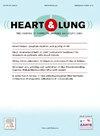apelins能指导COPD患者冠状动脉疾病的诊断吗?
IF 2.6
4区 医学
Q2 CARDIAC & CARDIOVASCULAR SYSTEMS
引用次数: 0
摘要
apelins是一种脂肪因子,以其抗炎、血管扩张和抗动脉粥样硬化作用而闻名。它们参与慢性阻塞性肺疾病(COPD)和冠状动脉疾病(CAD)等慢性疾病的发病机制。目的探讨apelin作为COPD患者CAD早期诊断和治疗的潜在生物标志物。方法纳入2023年6月至2024年6月期间入院的73例稳定期COPD患者和35名年龄和性别匹配的健康志愿者。将COPD患者分为两组:无CAD组(1组)和有CAD组(2组)。采用ELISA法检测血清中apelin 12、13、17和36的水平。结果COPD患者血清apelin水平明显低于对照组(p <;0.001)。在COPD患者中,冠心病患者血清中apelin水平低于非冠心病患者(apelin 12的p = 0.005, p <;apelin 13,17和36为0.001)。ROC分析显示,apelin 13和36在预测COPD患者CAD方面具有较高的敏感性和特异性。Apelin 13、36与射血分数(EF)呈正相关(R = 0.43, p = 0.01;R = 0.4, p = 0.01), apelin 12与FEV1、FVC呈正相关(R = 0.24, p = 0.04;R = 0.27, p = 0.02)。结论虽然CAD恶化了COPD患者的预后,但仍未得到充分诊断。血清apelin,特别是apelin 13和36,可能有助于COPD患者CAD的早期诊断和治疗。本文章由计算机程序翻译,如有差异,请以英文原文为准。
Can apelins guide the diagnosis of coronary artery disease in COPD patients?
Background
Apelins are adipokines known for their anti-inflammatory, vasodilator, and antiatherosclerotic effects. They are involved in the pathogenesis of chronic diseases like chronic obstructive pulmonary disease (COPD) and coronary artery disease (CAD).
Objectives
This study aims to investigate apelin as a potential biomarker for early diagnosis and management of CAD in COPD patients.
Methods
The study included 73 stable COPD patients admitted between June 2023 and June 2024 and 35 healthy volunteers matched by age and gender. COPD patients were categorized into two groups: those without CAD (Group 1) and those with CAD (Group 2). Serum levels of apelin 12, 13, 17, and 36 were measured using ELISA.
Results
Serum apelin levels were significantly lower in COPD patients than in controls (p < 0.001). Among COPD patients, those with CAD showed lower serum apelin levels compared to those without CAD (p = 0.005 for apelin 12, p < 0.001 for apelin 13, 17, and 36). ROC analysis indicated high sensitivity and specificity for apelin 13 and 36 in predicting CAD in COPD patients. Apelin 13 and 36 were positively correlated with ejection fraction (EF) (R = 0.43, p = 0.01; R = 0.4, p = 0.01), and apelin 12 was positively correlated with FEV1 and FVC (R = 0.24, p = 0.04; R = 0.27, p = 0.02).
Conclusion
While CAD worsens the prognosis in COPD patients, it remains underdiagnosed. Serum apelin, especially apelin 13 and 36, may assist in the early diagnosis and management of CAD in COPD patients.
求助全文
通过发布文献求助,成功后即可免费获取论文全文。
去求助
来源期刊

Heart & Lung
医学-呼吸系统
CiteScore
4.60
自引率
3.60%
发文量
184
审稿时长
35 days
期刊介绍:
Heart & Lung: The Journal of Cardiopulmonary and Acute Care, the official publication of The American Association of Heart Failure Nurses, presents original, peer-reviewed articles on techniques, advances, investigations, and observations related to the care of patients with acute and critical illness and patients with chronic cardiac or pulmonary disorders.
The Journal''s acute care articles focus on the care of hospitalized patients, including those in the critical and acute care settings. Because most patients who are hospitalized in acute and critical care settings have chronic conditions, we are also interested in the chronically critically ill, the care of patients with chronic cardiopulmonary disorders, their rehabilitation, and disease prevention. The Journal''s heart failure articles focus on all aspects of the care of patients with this condition. Manuscripts that are relevant to populations across the human lifespan are welcome.
 求助内容:
求助内容: 应助结果提醒方式:
应助结果提醒方式:


